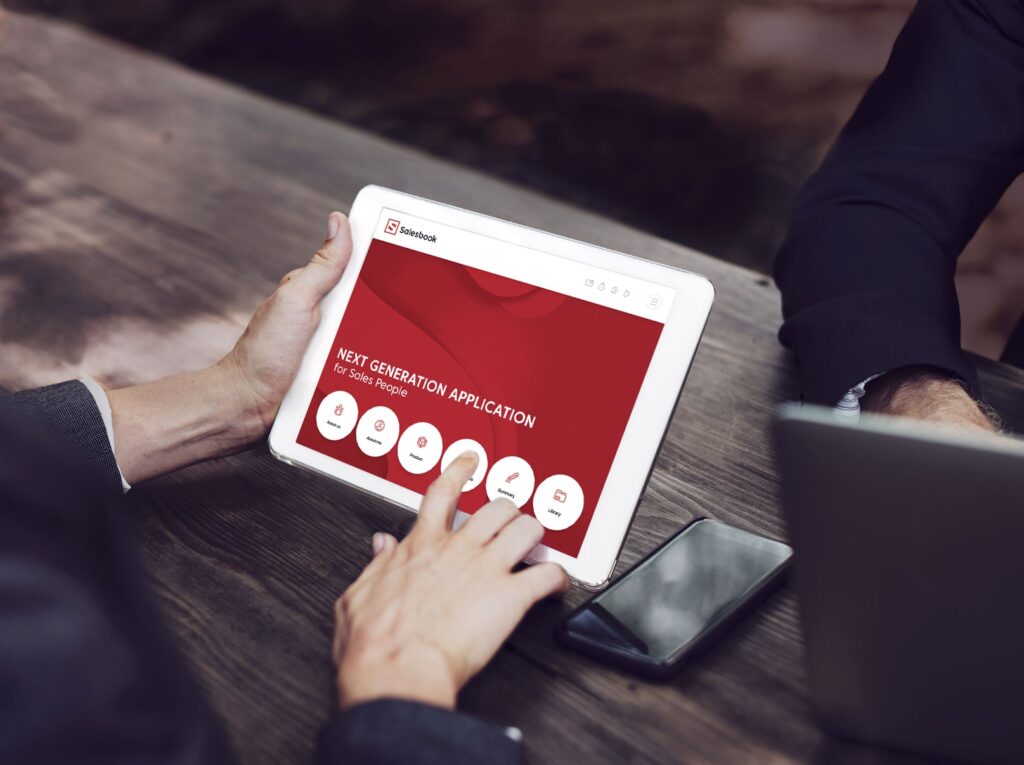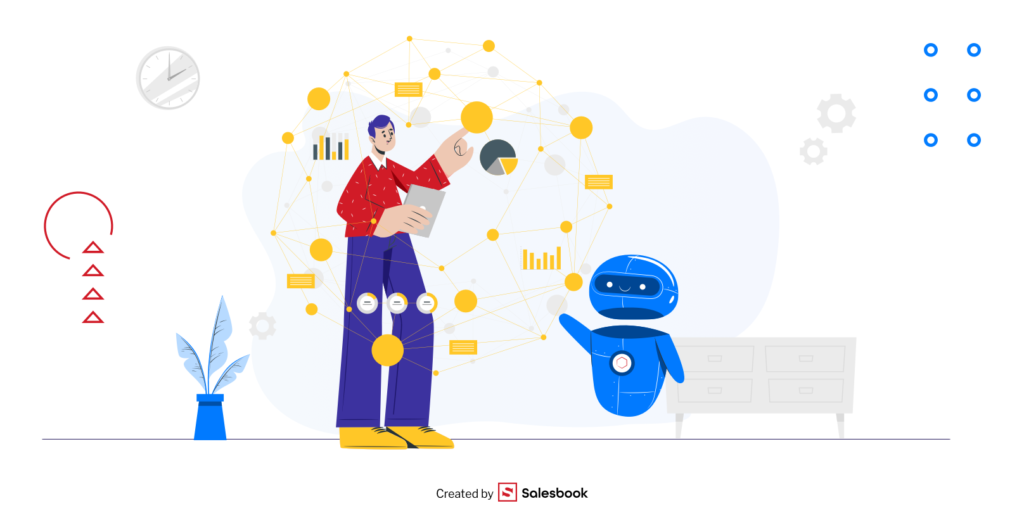The sales process: definition, stages, and examples.
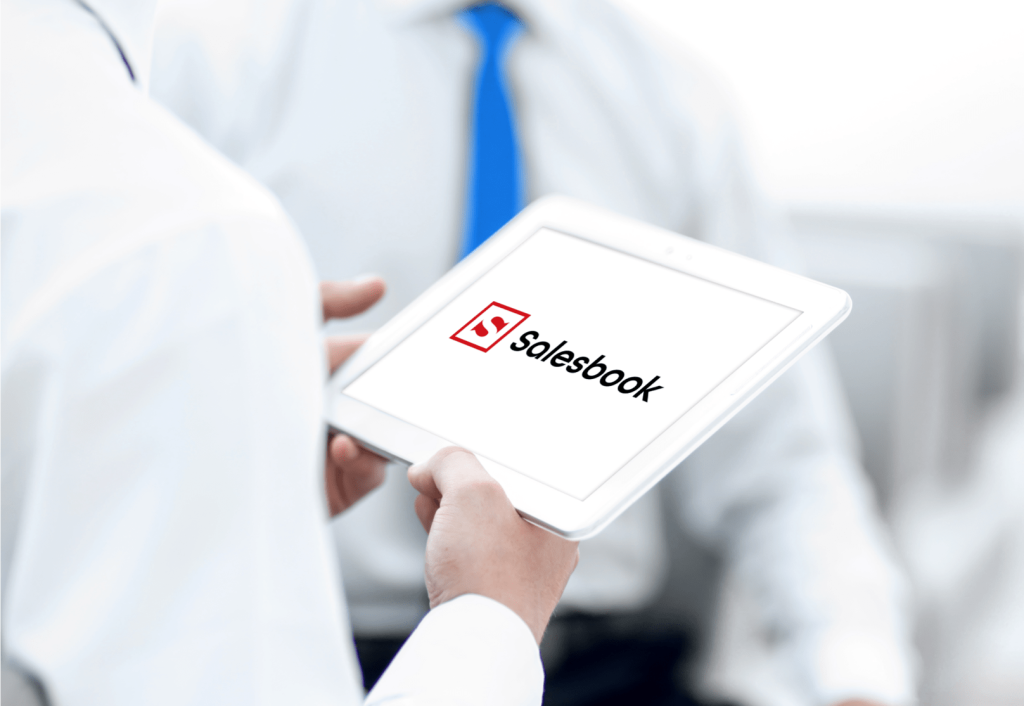
What is a sales process, and why do some companies consistently outperform their competitors, while others seem to be stuck in place? It’s not about luck. It’s not about price. And it’s not even about the product.
In most cases, it comes down to one thing: a thoughtfully designed and effectively managed sales process that guides a potential customer from the very first contact all the way to the final decision—without chaos, guesswork, or unnecessary losses.
In this article, we’ll explore:
- what the sales process looks like in real-world scenarios,
- why managing the sales process isn’t just the manager’s responsibility,
- how to increase conversions at every stage of the sales journey,
- and how to create a sales process that works—even when your top sales rep is on vacation.
We’ll also give you real B2B examples you can use. The goal? To help you not just understand what a sales process is, but to implement it—right here, right now.
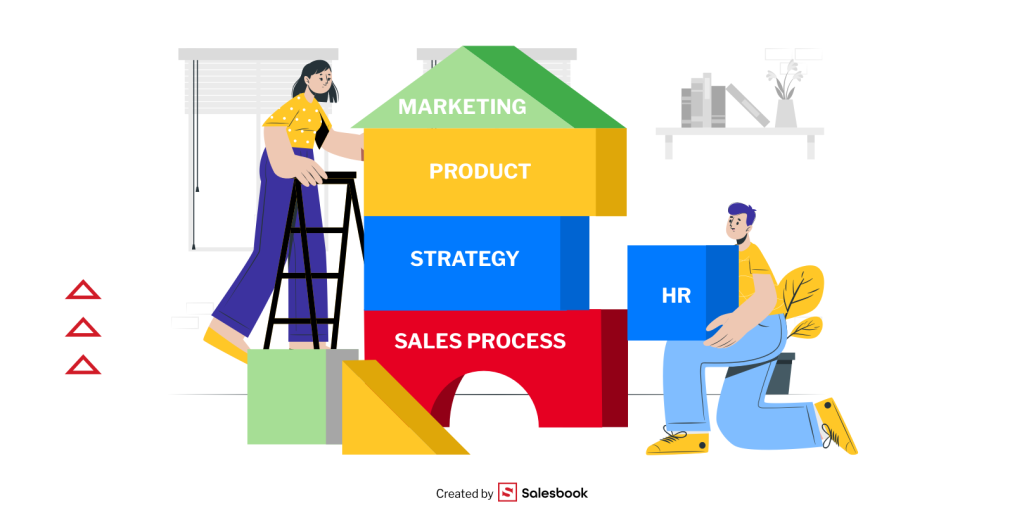
What Is a Sales Process? A Definition That Matters in Business
Before we dive into how to design an effective sales process, let’s begin with a foundational understanding of what it really means—and why it’s so important for every sales team.
A sales process is a repeatable set of steps that a company’s sales professionals follow to guide a prospect from initial contact to a closed deal and beyond. It provides clarity, direction, and consistency at each phase of the sales cycle.
In theory, the sales process serves as a framework or sales methodology. It defines what should happen, in what order, and why. In practice, it helps sales managers and their teams align on expectations, actions, and goals—creating a path that every rep can follow, measure, and improve.
Without a defined sales process, organizations often find themselves with inconsistent results, inefficient handovers, and missed opportunities. Each rep improvises, every conversation feels different, and the sales pitch varies wildly depending on who’s talking. That’s not agility—it’s risk.
This is exactly why a standardized sales process is critical. It ensures that whether you’re onboarding new team members, launching a new product, or entering a new market, your sales team has a shared understanding of what works and how to execute it.
Sales managers, in particular, rely on a structured sales process to coach more effectively, track performance at each stage of the selling process, and identify bottlenecks. Rather than react to results, they can proactively manage outcomes.
Think of it this way: Without a roadmap, even the most skilled driver can get lost. A sales process is that roadmap—and the more precisely it’s defined, the more efficiently your team can navigate from lead to loyal customer.
The Sales Process in Theory and Practice
A sales process is a repeatable sequence of actions that transforms a potential customer into a paying one. The keyword here is repeatable.
In theory, it’s a model that outlines the individual stages of the sale, their order, and their purpose. In practice, it’s a system that can either become your greatest asset—or a weight dragging you down.
Understanding what a sales process is marks the first step toward effective sales. And yet, this step is often skipped. Many companies operate the old-fashioned way: sending out offers blindly, cold-calling without a plan, reacting instead of strategizing. That’s why the effectiveness of the sales process drops, and sales reps spend more time putting out fires than actually selling.
A Practical Definition of the Sales Process:
A sales process is a set of steps a salesperson takes to guide a potential customer through the journey—from initial contact, through needs discovery, to closing the deal and providing post-sale support.
But that’s not the full picture.
A good process doesn’t end with a signed contract. In modern B2B, it should also include post-sale actions—because at which stage of the buying journey does a customer truly decide whether to stay with you long term? Usually… after the purchase.
That’s why designing a sales process shouldn’t be a one-off task. It’s something that evolves alongside your market, your product, and your team.

Why Is It Worth Standardizing Your Sales Process?
Imagine a company where every sales rep conducts conversations differently, each one identifies customer needs their own way, presents offers in a completely different style, and—most importantly—has their own idea of when to “close” a deal.
That doesn’t sound like chaos. That is chaos.
A lack of standardization leads to:
- no way to analyze performance at different stages of the sales process,
- difficulty scaling the team,
- inconsistent customer experience,
- and extremely low predictability of results.
On the other hand, a well-designed sales process allows you to:
- onboard new salespeople quickly,
- measure conversion rates at every stage of the sales process,
- identify bottlenecks in the pipeline,
- and make decisions based on data—not gut feeling.
According to Harvard Business Review, companies that implemented a systematic sales process reported a 15–20% increase in revenue within two years. Even more impressively, their teams performed better regardless of turnover or seasonality.
Standardization = scalability + repeatability + quality.
It’s important to remember that managing a sales process isn’t about lengthy reports or rigid procedures. It’s about creating a shared language, a common set of tools, and a steady rhythm for your team’s daily work.
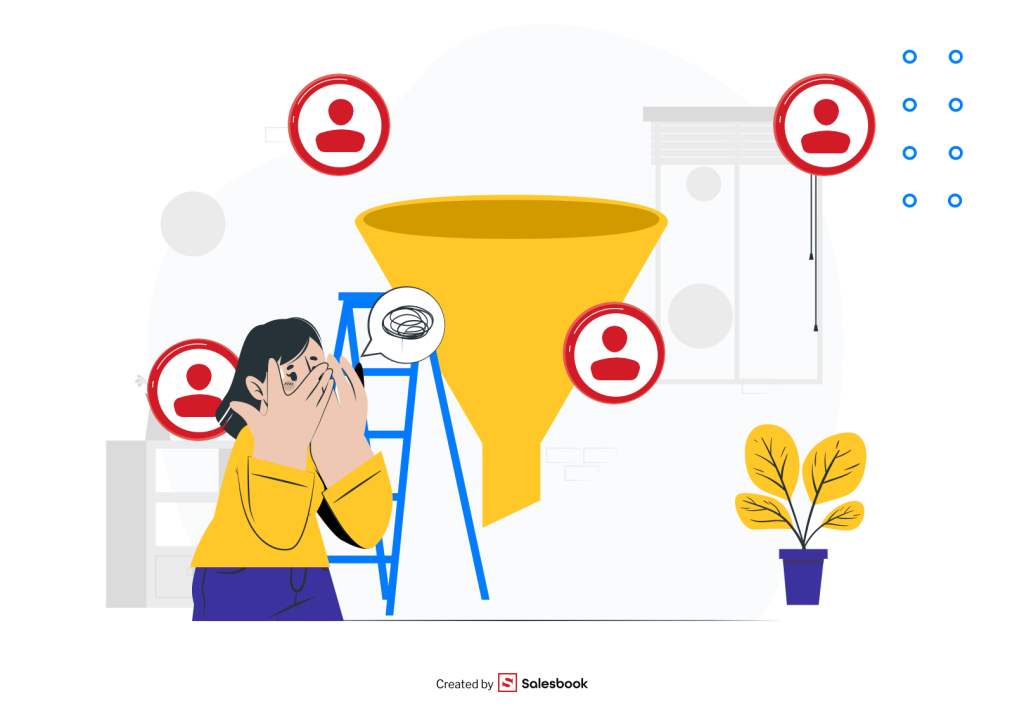
Sales Stages – What Really Matters in a Modern Approach
If your sales process is the journey, then each stage of the sales process is a crucial milestone—helping you navigate from initial contact to a signed contract with precision and purpose. These stages don’t just guide your team internally—they shape the experience of your potential clients, align sales efforts with the buyer’s journey, and ultimately impact sales performance.
A clearly structured approach allows both marketing teams and sales representatives to identify where each potential client stands in the funnel and tailor their messaging accordingly. Without defined and strategically aligned sales stages, your team risks missing key signals, repeating unproductive actions, or failing to address the pain points that truly matter to your target audience.
Today’s market demands more than rigid, one-size-fits-all templates. To truly improve sales performance, businesses must go beyond outdated methodologies and embrace flexible, data-informed frameworks that adapt to real-world buying behaviors—especially in the digital age, where online research often happens before a conversation even begins.
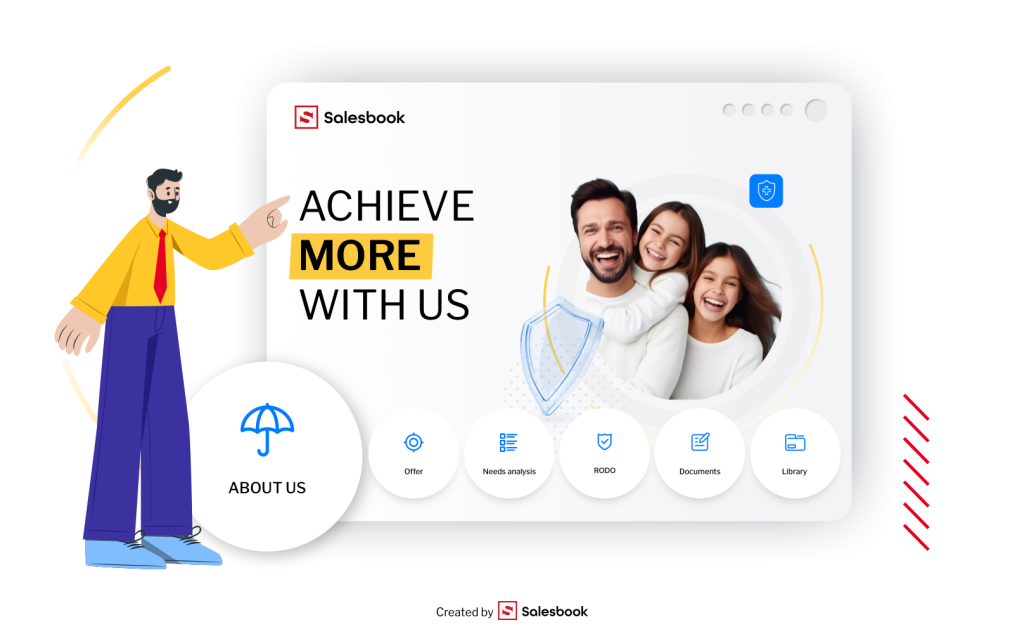
A repeatable sales cycle built on clearly mapped stages supports a strong sales process that’s both scalable and predictable. It ensures that every rep knows not just what to do, but why it matters at each stage of the sales process—whether it’s uncovering pain points, demonstrating key benefits, or reinforcing value to drive decisions.
If you’re looking to optimize your current sales process, start by revisiting the structure of your sales stages. Are they aligned with your buyers’ real-life journey? Are they helping—or hindering—your ability to build relationships and close deals?
Modern sales success starts with clarity—and that begins with the right stages.
The Classic Approach – Seven Step Sales Process (With Examples)
Let’s start with the basics. The classic sales process is built around seven core stages, found in almost every sales manual. It’s a great starting point for implementing a sales process before moving on to more advanced models.
Here are the 7 key stages of the sales process:
1. Prospecting (Finding Leads)
Identifying a potential customer, meaning someone or a company that could benefit from your solution.
Example: A SaaS company creates a list of logistics firms with annual revenue over PLN 10 million.
2. Initial Contact
The first interaction with the lead—via phone, email, or LinkedIn.
Goal: Spark interest and schedule a follow-up meeting.
3. Lead Qualification
Assessing whether the potential client matches your ICP (Ideal Customer Profile).
Questions: Do they have a budget? Do they have a clear need? How fast do they make decisions?

4. Product Presentation and Needs Discovery
This stage of the sales process is all about understanding the customer’s needs and showing how your solution addresses them.
Pro tip: Ask instead of pitch. Smart questions are often the best form of presentation.
5. Objections and Negotiations
A true test of the salesperson’s skills. Don’t just handle objections—anticipate them.
Example: If the client is worried about onboarding, present a case study from a similar industry.
6. Closing the Sale / Finalizing the Deal
The moment the contract is signed. Finalizing the transaction should be a natural outcome of previous steps.
Tip: Don’t ask “Are you ready to move forward?” Ask, “When would you like to begin implementation?”
7. Follow-up and Post-Sale Support
A rarely discussed but critical part of the process—especially for retention and cross-sell opportunities.
Action: Send a follow-up email with a summary, a report, a helpful resource, or an invitation to a webinar.
Each of these stages should be clearly defined and documented—both in your CRM system and in your sales team’s playbook. This allows you to measure the effectiveness of your sales process at the micro level—on a stage-by-stage basis.
If you’re looking for a proven, modern framework powered by real sales tools, check out the Salesbook Formula—our proprietary, step-by-step sales process: read the article.
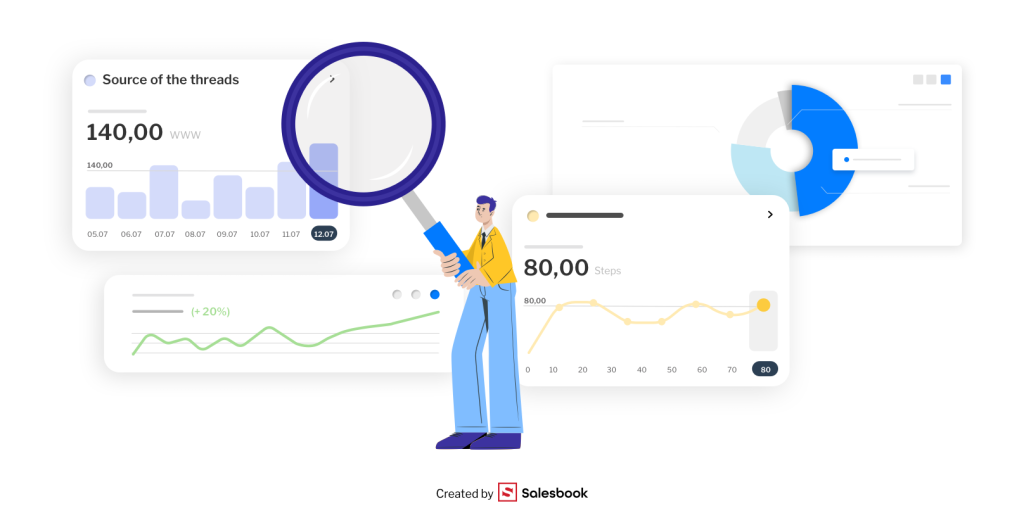
Modern Sales Methodologies – From SPIN to Challenger Sale
While the classic sales process still works, it doesn’t always fit the complexity of B2B transactions or consultative selling. That’s where modern sales models come into play—such as SPIN Selling, Solution Selling, MEDDIC, and Challenger Sale.
SPIN Selling (Neil Rackham)
This model is based on four types of questions:
- Situation – questions about the customer’s current state,
- Problem – identifying the challenges they face,
- Implication – understanding the consequences of not addressing the problem,
- Need-payoff – showing what the client will gain from your solution.
Which stage of the sales process?
SPIN works best during needs discovery and solution presentation.
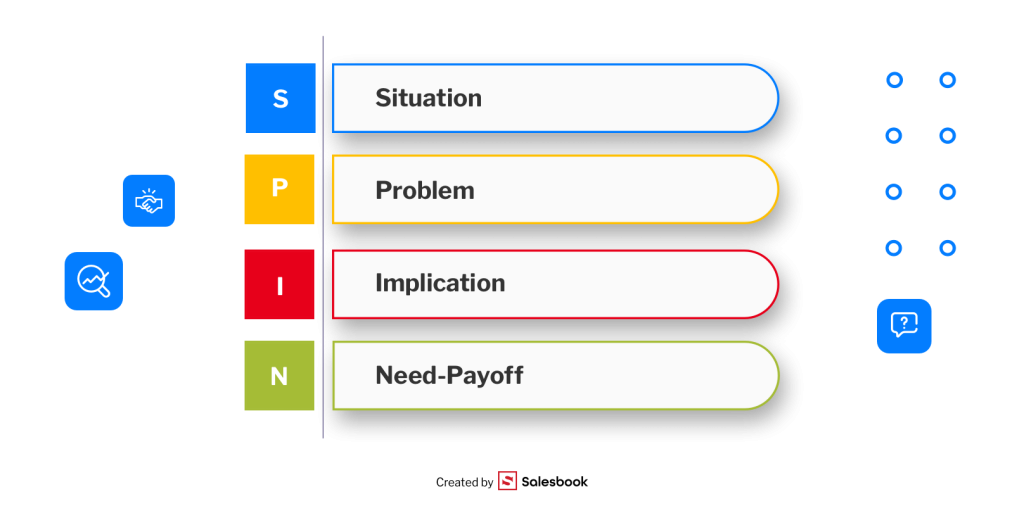
Challenger Sale (Matthew Dixon, Brent Adamson – source)
In this model, the salesperson acts as a trusted advisor who educates the customer, challenges their current way of thinking, and opens their eyes to new opportunities.
Best for:
Innovative products or services where the customer may not yet recognize a need.
MEDDIC
A qualification-based sales process built around six core elements:
- Metrics – What measurable impact will the solution deliver?
- Economic Buyer – Who controls the budget?
- Decision Criteria – What factors influence the purchase?
- Decision Process – How is the decision made?
- Identify Pain – What is the key problem to solve?
- Champion – Who will advocate for your solution internally?
Ideal for:
Evaluating whether a lead has a strong chance of converting.
In practice, many sales teams now blend these methods—tailoring their approach based on the type of client and the stage of the customer’s buying journey they’re in.

How to Tailor the Sales Process Stages to Your Product or Service
There’s no such thing as a one-size-fits-all sales process. Everything depends on:
- the length of the buying cycle,
- the complexity of your product,
- the number of decision-makers on the client’s side,
- and your business model (B2B vs. B2C).
So how do you define the right stages?
Step 1: Map out your customer’s typical journey
Think about which stage of the sales process usually triggers questions, objections, or hesitation.
Step 2: Align it with your sales team’s actions
What does the lead contact look like? When does the presentation happen? How often do clients ask for a quote?
Step 3: Introduce minimal standardization
You don’t need 12 stages. Sometimes, 4–5 well-defined steps are more than enough—as long as they’re clear, actionable, and consistently used.
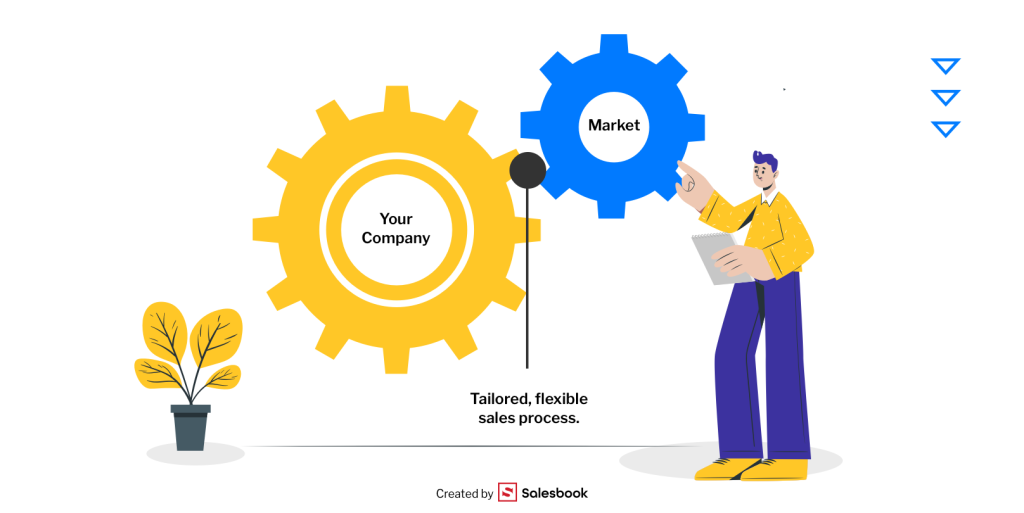
What Does Effective Sales Process Management Really Mean?
Every company eventually hits a familiar wall: salespeople are working hard, but the results are unpredictable. One rep closes 10 deals, another closes none. No one really knows what worked, what failed, or at which stage of the sales process everything fell apart.
Why?
Because there’s no real sales process management—just gut-feeling execution. And in modern B2B sales, that’s simply not enough.
Effective management boils down to three key elements:
- a clearly defined and implemented sales process tailored to your organization,
- tools that enable activity tracking—like a robust CRM system,
- and a sales leader who doesn’t just assign targets but actively supports the team through each stage of the process.
The Sales Process and CRM – How Technology Supports Management
Before CRMs became the norm, managing the sales process felt like playing Battleship. Sales reps marked updates in spreadsheets, managers scribbled numbers in notebooks, and reports had a life of their own.
Today, sales through a CRM system is essential—not just for organization, but for making informed business decisions.
How does a CRM support sales management?
- It lets you track conversions across individual stages of the sales process.
- It reveals exactly where leads are dropping out of the pipeline.
- It enables automated follow-ups and reminders to schedule the next meeting.
- It helps analyze the time to close a deal—and optimize it.
Example:
In Salesbook’s CRM, a sales rep can instantly see how many potential customers moved from the “Offer” stage to “Negotiation”—and how many deals were closed. A manager can then act right away—without waiting for quarterly results.
More importantly, the CRM captures every activity, making it easier to measure the effectiveness of the sales process—not just by the number of closed deals, but by the quality and frequency of actions taken along the way.
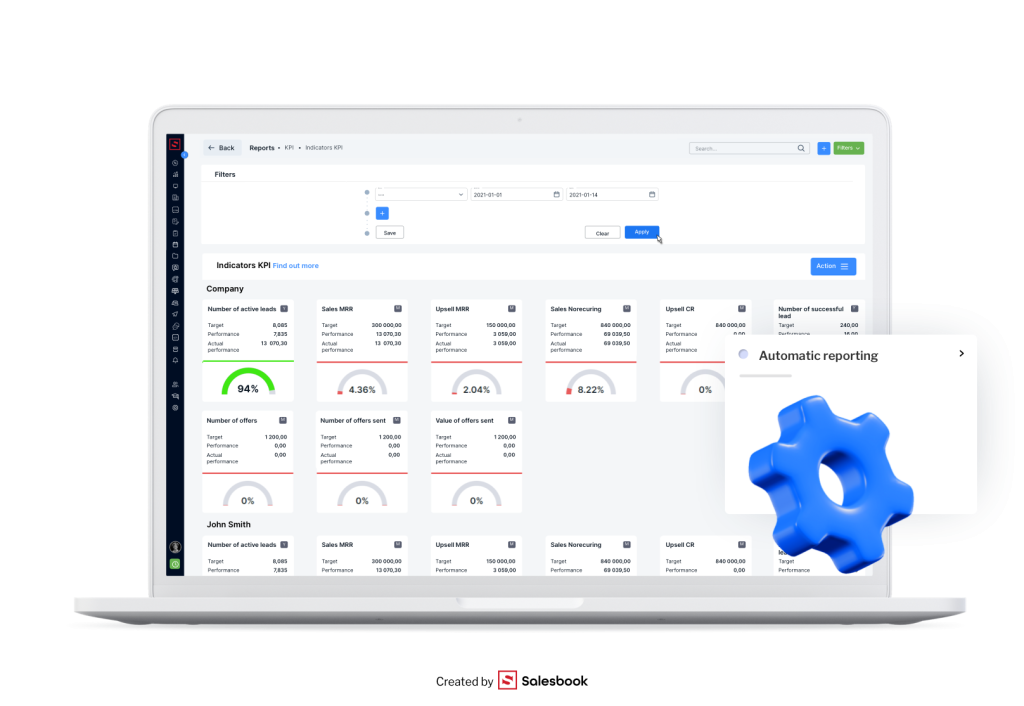
The Role of a Sales Manager in Managing the Sales Process
Sales management isn’t about managing people—it’s about managing the process that supports those people. A good process helps sales reps perform better; it doesn’t judge them.
A great manager understands that team performance isn’t only about a salesperson’s personality. It’s about whether:
- they know which stage of the sales process they’re in,
- they understand the customer’s needs,
- they can tailor their communication to match the buyer’s decision stage,
- and they consistently build relationships—not just “close deals.”
Key responsibilities of a sales manager:
- Training the team to use the CRM and follow process standards,
- Analyzing both outcomes and behaviors—not just final numbers,
- Giving real-time feedback—not after the deal is lost, but while it’s in motion,
- Co-creating and optimizing the sales process, rather than just copying a template.
In practice:
A manager notices that 70% of leads drop off during the “Needs Analysis” stage. They listen to call recordings and realize that reps aren’t asking the right questions. The solution? A SPIN Selling workshop. The result? Better understanding of client needs, more demo meetings, and a shorter time to close.
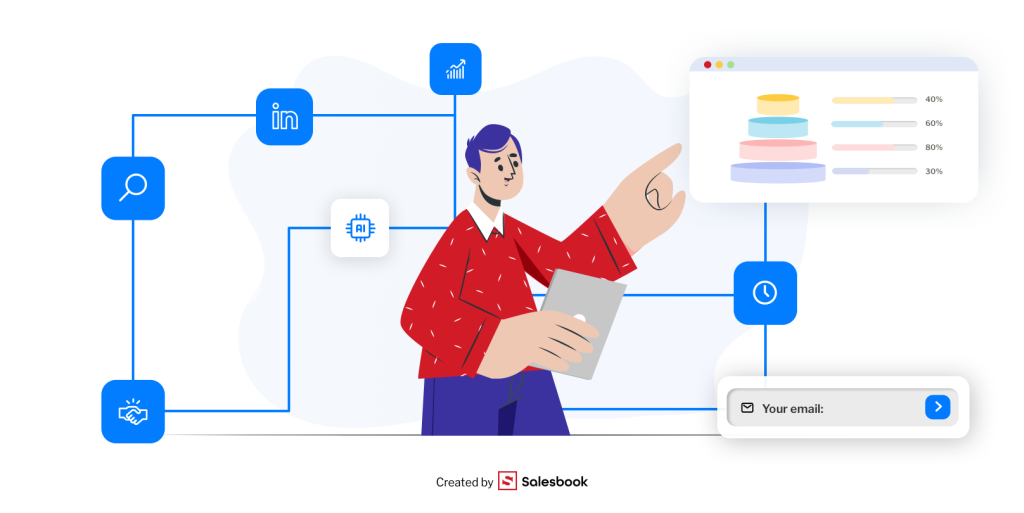
Key Sales KPIs for Managing the Sales Process
You can’t manage what you don’t measure. That’s why KPIs are so critical—especially in B2B sales, where the decision-making cycle is long and complex.
The most important sales KPIs include:
- Number and quality of new leads
(i.e., how effectively are you identifying potential customers?) - Conversion rate at each stage of the sales process
(how many leads move from one stage to the next?) - Average time to close
(measured in days or weeks) - Sales pipeline value
(how much potential revenue is currently active?) - Sales opportunity loss rate
(and at which stage of the sales process leads are being lost) - Sales activity volume
(calls, emails, meetings—pulled from CRM data) - Time to respond to a customer inquiry
(do reps reply within an hour, or within a week?)
Pro tip: KPIs aren’t meant to punish—they’re diagnostic tools. If a rep has 30 meetings but low conversions, they may be missing the mark with messaging. If a customer started a free trial but vanished, maybe there was a gap in relationship building or onboarding support. This is where a great manager steps in—not as a controller, but as a coach.

What Does Each Stage of the Sales Process Look Like in Practice?
On paper, it all seems perfect: a lead enters the CRM, the rep makes a call, presents the offer, negotiates, closes the deal, and pops the champagne. But in reality, the sales process is anything but linear. It’s a winding road where the customer’s needs often shift along the way.
That’s why it’s crucial not only to understand the structure of the sales process, but also to know what really happens at each stage.
From First Contact to Closing – A Step-by-Step Guide
Below is a sample sales process based on real-world experience from B2B teams, particularly in tech companies. Each stage includes the salesperson’s actions, business objectives, and the customer’s perspective—because an effective sales process leads to a decision, not just another CRM report.
1. Lead Identification and First Outreach
Goal: Identify a potential customer who fits your ICP and shows buying signals.
Tools: LinkedIn, cold emailing, webinars, referrals.
Key principle: Don’t try to sell—try to understand.
This stage is about gathering context, understanding the customer’s needs, and creating the first meaningful touchpoint.
2. Qualification and Needs Discovery
Goal: Determine whether the contact is worth pursuing and whether the timing is right.
Questions to ask: What challenges are you trying to solve? What are you currently using? What would you like to improve?
Tip: At this point, the sales process involves a consultative role—you’re positioning yourself as an expert, not just a seller.

3. Solution Presentation (Demo / Proposal)
Goal: Show how your product or service solves the customer’s specific problems.
Skip the slides—use real-life examples. If possible, give the client a chance to test features or schedule a personalized demo.
Tip: Every presentation should be based on prior analysis. Don’t show everything—show what addresses their pain.
4. Negotiations and Objections
Goal: Adjust the offer to reflect the customer’s reality and reach a mutual “yes.”
Don’t: Drop the price on the first objection—it undermines both your process and your perceived value.
Do: Ask strategic questions instead, like “What would help you make a decision today?”
5. Finalizing the Transaction
Goal: Close the deal and begin the onboarding process.
Actions: Draft the contract, agree on an implementation timeline, and hand off the client to Customer Success.
Tip: Don’t treat signing the contract as the end. In many companies, the sales process is also the start of a long-term relationship. A smooth finish = future referrals and upsell opportunities.

The Most Common Mistakes at Each Stage of the Sales Process – and How to Avoid Them
There’s no such thing as a flawless process—but there are predictable pitfalls that repeatedly weaken the effectiveness of the sales process. Below is a checklist of the most common errors—along with proven ways to avoid them:
Stage 1 – Lead Identification
Mistake: Focusing on the wrong contacts or random companies.
Solution: Define your ICP (Ideal Customer Profile)—size, industry, challenges, key decision-makers.
Stage 2 – Needs Discovery
Mistake: Jumping to the pitch too early, without fully understanding the problem.
Solution: Use frameworks like SPIN or GPCT (Goals, Plans, Challenges, Timeline) to dig deeper.
Stage 3 – Product Presentation
Mistake: Presenting every single feature all at once, without any context.
Solution: Customize the demo based on what the customer actually said they need to solve.
Stage 4 – Negotiations
Mistake: Panicking at the first objection—and immediately offering a discount.
Solution: Ask, “What’s behind that hesitation?” The issue might be onboarding, not pricing.
Stage 5 – Deal Closing
Mistake: Lack of clarity, delays, or no clear point of contact on the customer’s side.
Solution: Prepare an onboarding checklist, define a communication flow, and plan the next steps upfront.
Final thought:
If you want to control the sales process, you need more than just a CRM—you need awareness. Every stage is an opportunity to deepen relationships, not just tick off another “status.” That’s the key to effectively implementing a sales process that grows alongside your business.
Sample B2B Sales Process – A Real Case Study
Even the best theory can’t replace a concrete example. So let’s walk through what a well-designed sales process in a B2B company looks like—step by step, from initial contact to closing the deal and post-sale follow-up.
In this scenario, we look at a tech company offering a project management system for mid-sized and large teams. Their sales process is CRM-driven, involves multiple departments, and reflects the reality of the customer’s buying journey.
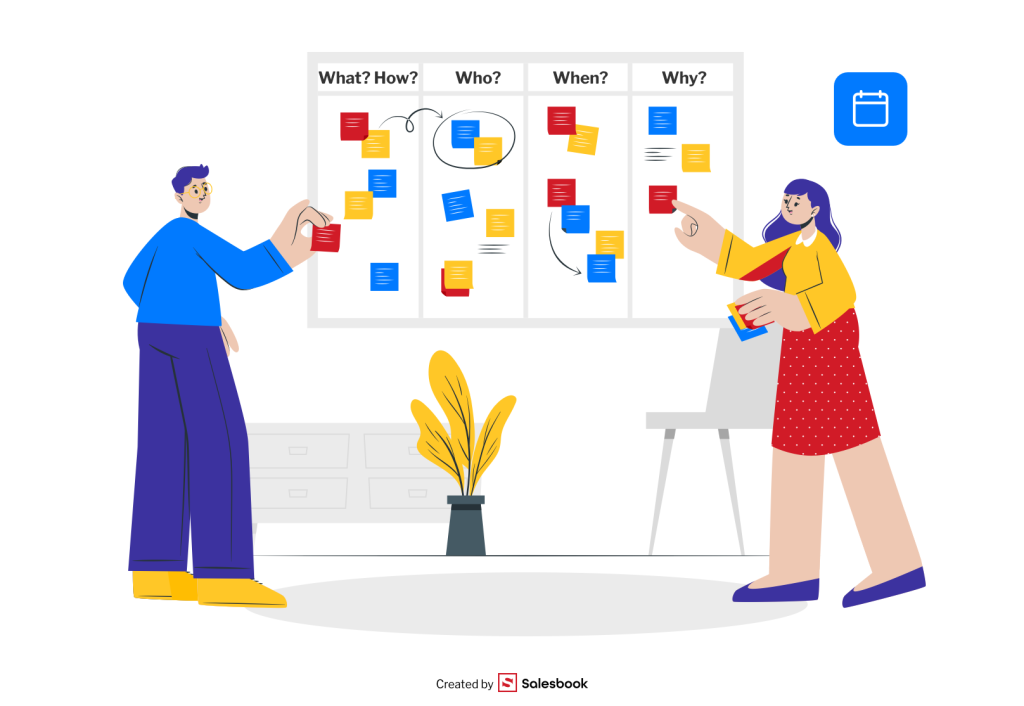
Step-by-Step Sales Call Scenario
Context:
The lead comes from an inbound campaign—the client downloaded an e-book and submitted their contact info. They’re entered into the CRM and automatically receive a thank-you email and an invitation to connect.
Stage 1 – Intro Call (Day 1):
The sales rep calls to thank the lead for downloading the content and to ask a few qualifying questions. The goal is to understand which stage of the buying process the client is in.
Sample questions:
- What prompted you to download the material?
- What tools are you currently using?
- Which areas would you like to improve?
Stage 2 – Demo & Needs Analysis (Day 4):
During an online meeting, the rep only shows the features that address the client’s previously stated needs. This is the moment where sales becomes real—because the client sees clear value.
Pro tip:
Always leave space for questions. Better conversations lead to long-term relationships.
Stage 3 – Proposal (Day 6):
The rep sends a personalized offer and proposes a meeting to go over the details. They emphasize support during implementation, training, and post-launch assistance.
Stage 4 – Follow-Up & Decision (Days 10–14):
The client reviews the proposal internally. The rep checks in and asks clarifying questions to uncover any remaining concerns and gauge which stage of the buying process they’re currently in.
Stage 5 – Closing the Sale & Onboarding (Day 15+):
The contract is signed, and the client is handed over to the Customer Success team. Within a week, there’s a kick-off call and onboarding begins. A month later, a customer satisfaction check is conducted.
This process is repeatable, measurable, and supported by a CRM system. That’s not by chance—it’s the result of a deliberately designed sales process.
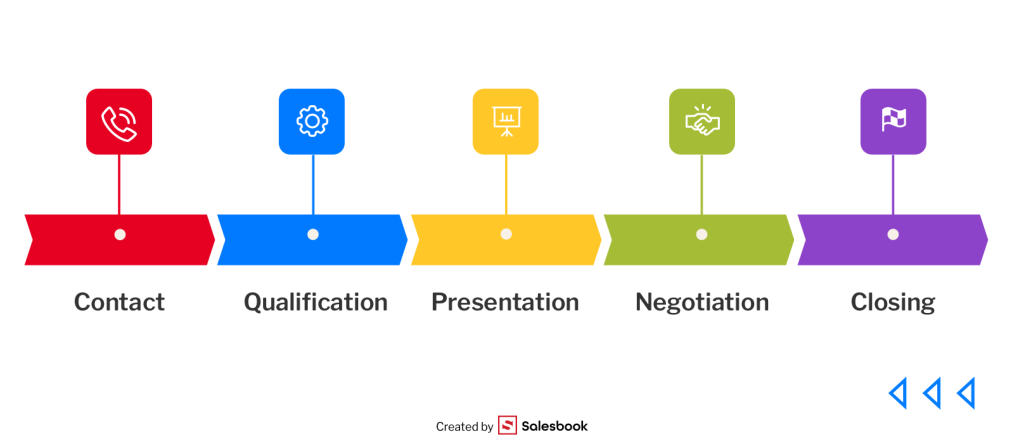
What Does a Well-Designed Sales Funnel Look Like?
A sales funnel isn’t just about collecting as many leads as possible and crossing your fingers. Instead, it’s a strategic framework that mirrors the buyer’s journey—aligning every step your sales team takes with what the prospect’s business truly needs, when they need it.
A high-performing funnel doesn’t chase volume for volume’s sake. It’s about sales leaders guiding their teams to focus on quality over quantity, precision over guesswork. The goal is to build a sales process that not only supports conversions but also builds relationships—by helping reps actively listen, personalize interactions, and tailor sales tactics to each unique scenario.
A well-structured funnel should:
- Reflect real steps in the buyer’s journey, not just internal reporting needs
- Prioritize quality leads who fit your sales targets, rather than broad, unqualified traffic
- Track and optimize sales efforts through measurable conversion rates
- Allow your team to identify roadblocks and unlock opportunities for more sales
- Support personalization, nurturing, and long-term relationship-building
- Lay the groundwork for ensuring customer satisfaction from the first touchpoint to post-sale
A Sample Structure of a Well-Designed Funnel:
- Inbound / Outbound Lead Generation
Channels: cold emails, LinkedIn outreach, paid campaigns, events. - Qualification
Techniques: BANT, SPIN, or MEDDIC to assess readiness, budget, and fit with the prospect’s business. - Solution Presentation
Tools: tailored demos, case studies, and discovery calls that reflect real customer pain points. - Proposal and Negotiation
Focus: transparency, collaborative terms, and value—not just price. - Decision and Onboarding
Actions: contract signing, project kickoff, internal handover, and setup. - Post-Sale Activities
Includes: account management, cross-sell/upsell, loyalty building, and referrals.
Each step must be clearly defined so that sales reps follow a consistent yet flexible roadmap. KPIs, actions, and objectives should be attached to every stage to ensure clarity and enable meaningful analysis. This clarity also supports sales training, making onboarding new reps into your sales organization smoother and more effective.
Remember: A funnel isn’t a static diagram. It’s a dynamic engine for growth. And when you align it with the real buying behavior of your market, you don’t just get leads—you get more sales, stronger client relationships, and long-term success.

Looking for a Proven Blueprint?
If you’re not just looking for inspiration—but a real, battle-tested tool to guide you through all stages of B2B sales—check out the Salesbook Formula.
This isn’t just another framework. It’s a well-defined sales process, purpose-built for companies that want to move beyond theory and start closing deals with clarity, consistency, and confidence.
The Salesbook Formula is our proprietary, data-driven, and field-tested system, developed based on years of hands-on experience with high-performing sales teams. It’s designed to:
- use your CRM as the central hub for managing knowledge, activity, and customer relationships,
- streamline sales process mapping and execution across departments,
- integrate real-world insights from hundreds of successful implementations,
- and align seamlessly with the modern B2B buying journey—from qualified leads to long-term clients.
At its core, the Salesbook Formula helps you visualize and optimize every step through a clear sales process flowchart. You’ll see exactly how to move potential buyers through the funnel—from initial contact to discovery, from needs analysis to solution presentation, and from negotiation to a confident “yes.”
Whether you’re selling a complex product or service, entering a new target market, or scaling your sales operations, the Formula gives your team a repeatable blueprint to close deals faster, more predictably, and with better ROI with a full support of sales automation.
Learn more about this proven, structured sales process and download the full guide here:
Salesbook Formula – Everything You Need to Know About a Complete Sales Process
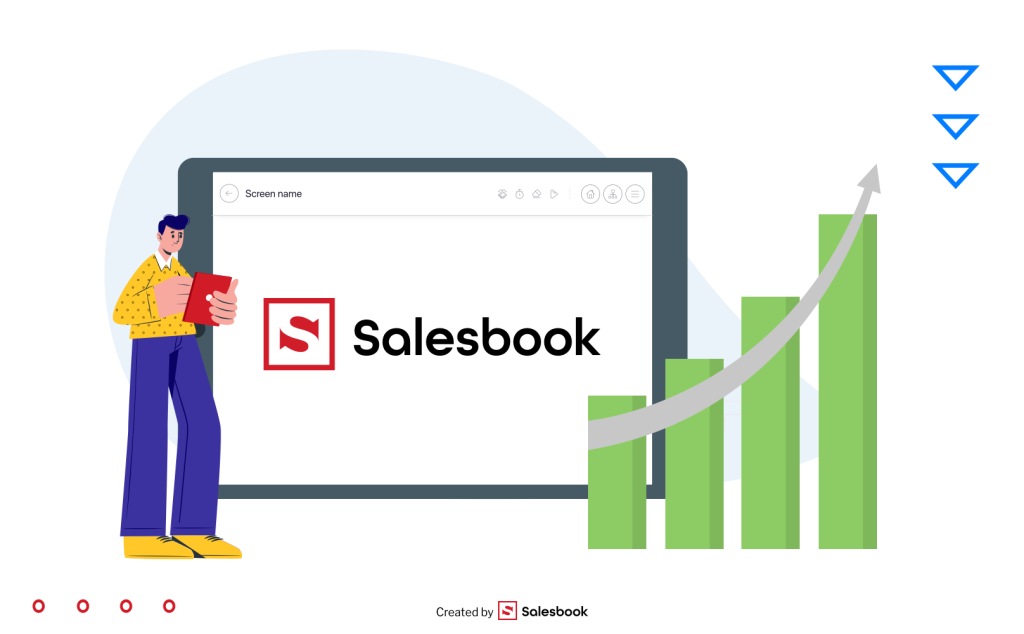
Summary: Why You Should Continuously Optimize Your Sales Process
A sales process isn’t a static PDF you draft once and shelve forever. It’s a dynamic, evolving framework—one that grows and adapts with your team, your product, your buyers, and the market. Like any key business system, it requires ongoing refinement, recalibration, and care.
Why?
Because everything around you is shifting. Your customers are changing. Your competitors are leveling up. Channels of communication are evolving, and the way decisions are made isn’t what it was a year ago. What used to be a winning formula might now be dragging you down.
That’s why optimization isn’t optional—it’s essential for sales process success.
If your goal is to:
- create a sales process that’s truly aligned with today’s buyer expectations,
- help your team sell smarter and close faster,
- shorten the sales cycle and lower the cost of customer acquisition,
- and deliver a seamless experience to every prospective customer,
then you need to look at your process not as a one-time setup, but as a continuous improvement loop.
This means going beyond surface-level fixes. Optimization isn’t just about renaming stages in your CRM or tweaking visuals in a playbook. It’s about improving the structure and flow of your sales process steps, one by one.
That includes:
- Aligning your messaging with where the buyer is in their journey through the sales process stages,
- Equipping reps to approach each sales call with value-focused insights—not just product talk,
- Understanding the psychology and timing behind each step of the sales process,
- And removing unnecessary friction that blocks progress or slows down conversions.
The most profitable sales process isn’t the one with the most features—it’s the one that’s easiest for your customer to navigate and your reps to execute. In other words, a clear, straightforward sales process that leads to consistent outcomes and repeat business.
One thing to keep in mind: Even a high-performing process will lose momentum if left untouched. That’s especially true in your company, where your team, market position, and product roadmap are in constant motion. What worked last quarter might now be one of the most common sales process mistakes—like skipping critical qualification steps or failing to personalize your follow-ups.
Table of Contents





